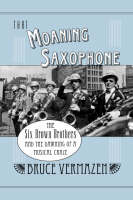
That Moaning Saxophone
The Six Brown Brothers and the Dawning of a Musical Craze
Seiten
2009
Oxford University Press Inc (Verlag)
978-0-19-537218-2 (ISBN)
Oxford University Press Inc (Verlag)
978-0-19-537218-2 (ISBN)
That Moaning Saxophone recovers the story of the Six Brown Brothers, the sextet often credited with starting the American saxophone craze. In sifting fact from legend, the book explores the show business world of 1895-1933: minstrelsy, circus, burlesque, recordings, Broadway, and the long, slow death of vaudeville.
The saxophone, today an emblem of "cool" and the instrument most associated with jazz, was largely ignored in the U.S. for well over a half-century after its invention in France in 1838. Bringing this new sound to the American public was the Six Brown Brothers, one of the most famous musical acts on the stage in the early twentieth century. The group's quarter-century of ups and downs mirror the rise and fall of minstrelsy and vaudeville. With treks across the country and Europe, years in Broadway musical and comedy revues, and even time at the circus, the Six Brown Brothers embodied early American music.
Rather than a note-by-note analysis of the music (the author is not a musicologist, but rather a cornet player, ragtime aficionado, and former philosophy professor), the book works with the music in its context, offering a cultural interpretation of blackface and minstrelsy, a history of the invention and evolution of the saxophone, and insight into the burgeoning American music/entertainment business and forgotten music traditions. While known among fans of early ragtime and saxophone players, Vermazen's rigorous archival research with primary sources repositions the Brothers in their rightful place as key players in the development of American music and popularizers of the saxophone. Through their live performances and groundbreaking recordings - the first of a saxophone ensemble - the Six Brown Brothers made this new and often derided instrument (once referred to as the "Siren of Satan") familiar to and loved by a wide audience, laying the groundwork for the saxophone soloists that have become the crowning symbol of jazz.
The saxophone, today an emblem of "cool" and the instrument most associated with jazz, was largely ignored in the U.S. for well over a half-century after its invention in France in 1838. Bringing this new sound to the American public was the Six Brown Brothers, one of the most famous musical acts on the stage in the early twentieth century. The group's quarter-century of ups and downs mirror the rise and fall of minstrelsy and vaudeville. With treks across the country and Europe, years in Broadway musical and comedy revues, and even time at the circus, the Six Brown Brothers embodied early American music.
Rather than a note-by-note analysis of the music (the author is not a musicologist, but rather a cornet player, ragtime aficionado, and former philosophy professor), the book works with the music in its context, offering a cultural interpretation of blackface and minstrelsy, a history of the invention and evolution of the saxophone, and insight into the burgeoning American music/entertainment business and forgotten music traditions. While known among fans of early ragtime and saxophone players, Vermazen's rigorous archival research with primary sources repositions the Brothers in their rightful place as key players in the development of American music and popularizers of the saxophone. Through their live performances and groundbreaking recordings - the first of a saxophone ensemble - the Six Brown Brothers made this new and often derided instrument (once referred to as the "Siren of Satan") familiar to and loved by a wide audience, laying the groundwork for the saxophone soloists that have become the crowning symbol of jazz.
Bruce Vermazen is Professor Emeritus of Philosophy, University of California, Berkeley.
1. IOnce a Legend ; 2. Father and Sons: 1858-96 ; 3. Darkest America: 1895-99 ; 4. The Traveling City: 1899-1909 ; 5. Struggling into the Big Time: 1905-11 ; 6. Beating the Competition: 1909-12 ; 7. Primrose and Dockstader's Minstrels: 1912-14 ; 8. All American Vaudeville: 1914 ; 9. Three Years with Montgomery and Stone: 1914-17 ; 10. Jack O' Lantern: 1917-18 ; 11. On the Road with Jack: 1918-20 ; 12. Tip Top: 1920-23 ; 13. Something New and Different: 1923-24 ; 14. Between Showings: 1924-27 ; 15. Nothing Left to Do in show Biz; 1928-88 ; 16. Maria Brown's Quilt ; Discography ; Key to Abbreviations ; Notes ; Index
| Erscheint lt. Verlag | 29.1.2009 |
|---|---|
| Zusatzinfo | 19 halftones |
| Verlagsort | New York |
| Sprache | englisch |
| Maße | 234 x 156 mm |
| Gewicht | 449 g |
| Themenwelt | Kunst / Musik / Theater ► Musik ► Jazz / Blues |
| ISBN-10 | 0-19-537218-2 / 0195372182 |
| ISBN-13 | 978-0-19-537218-2 / 9780195372182 |
| Zustand | Neuware |
| Haben Sie eine Frage zum Produkt? |
Mehr entdecken
aus dem Bereich
aus dem Bereich
zur politischen Ästhetik des Jazz
Buch | Hardcover (2023)
Phillip Reclam (Verlag)
38,00 €
Die Geschichte des Jazz in Deutschland
Buch | Softcover (2021)
Reclam, Philipp (Verlag)
20,00 €


